“Located on a private, protected cove of Great Moose Lake, the camp property extends for a mile and a half along the shores of this beautiful eight mile lake. Two picturesque fishing streams wind through the property, and a small private lake lies completely within its confines. The entire holding comprises nearly a thousand acres of unspoiled fields and woodland.”
From the first camp brochure written by William E. Trauth, Sr for Wild Goose Camp for Boys
*
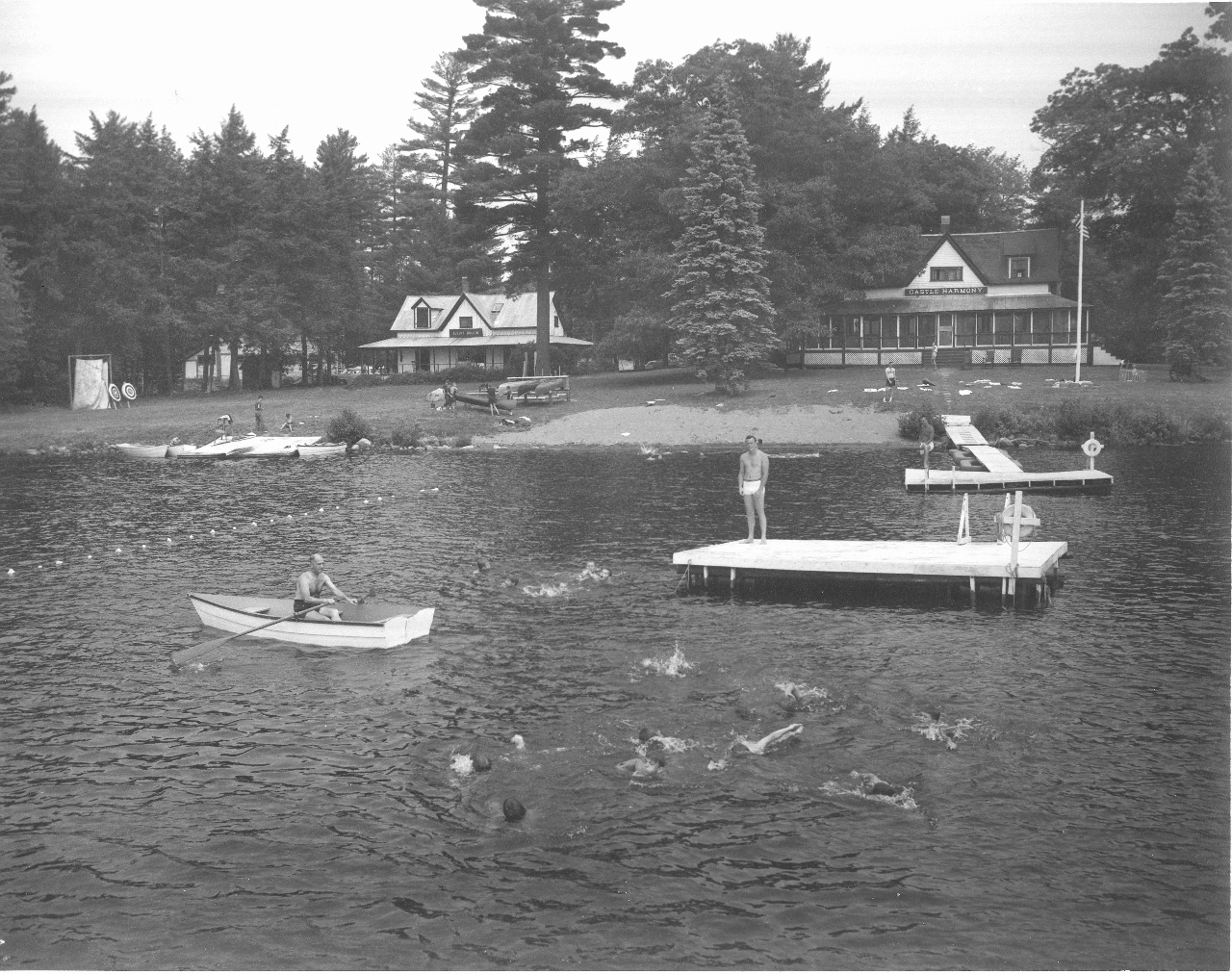
Wild Goose Camp for Boys | Castle Harmony Compound | Great Moose Lake | Harmony, Maine
*
As seen on our dedicated Wild Goose Club page, numerous old photos which had been left behind by Wild Goose Club Members at Castle Harmony after the club disbanded were recognized as important historical pieces and preserved by Theodore B. Hayward and his wife Dorothy Boehmler of Pennsylvania when they bought the property. We are eternally grateful to the Hayward Family for caring for these wonderful photos then passing them along to Bill & Lorna Trauth who in turn cared for them and graciously shared them so the story of the Wild Goose Club could be preserved and told to all.
As included in a 1956 article “The Wild Goose Club at Castle Harmony” by Paper Talks Magazine
“The members of the Wild Goose Club, who called themselves “Ganders”, would find quite a different population now inhabiting their camp – a lively, jolly, but very gentlemanly group of 30 young goslings under the charge of a New York school teacher named William Trauth, Sr. For where the old gentlemen from Boston once snared the now extinct wild pigeon is one of the finest and most carefully conducted boys’ camps in Maine – Mr. Trauth’s Wild Goose Camp for Boys.
Just a little more than a month ago I had the pleasure of visiting the camp, and had lunch with William and his wife, Lorna, their counselors and all the boys except those who were away on an over-night canoe trip. I was struck by the seemingly casual and flexible, yet actually carefully planned organization of the camp. Nowhere have I ever seen such uniformly good manners, natural and not obviously artificial, in a group of youngsters aged 8 to 13 – usually the most boisterous and unmannerly of ages. I suspect Wild Goose Camp today is much more quiet and orderly than was its predecessor, the Wild Goose Club, and I am sure it serves a much better purpose.
Mr. Trauth has carefully preserved the portraits, the albums, and the records of the old club, which were carelessly left on the premises when the property was sold by the sons and grandsons of old members, for the younger generation of those visiting Bostonians just didn’t care what happened to the old club. But Mr. Trauth has an eye for historic lore, and thanks to him we can today get a glimpse of how those Bostonians of the 1870′s spent their time in the Maine woods.”
*
In the Fall of 1955, former New York school teacher William “Bill” E. Trauth, Sr and his wife Lorna purchased the Castle Harmony property and opened the Wild Goose Camp for Boys at the former Wild Goose Club compound the following year on June 27, 1956. Bill would inherit the famous former Wild Goose Club head title as “The Commodore” while Lorna was affectionately known as “Mrs. T” to the hundreds of boys who attended their camp over the following decades.
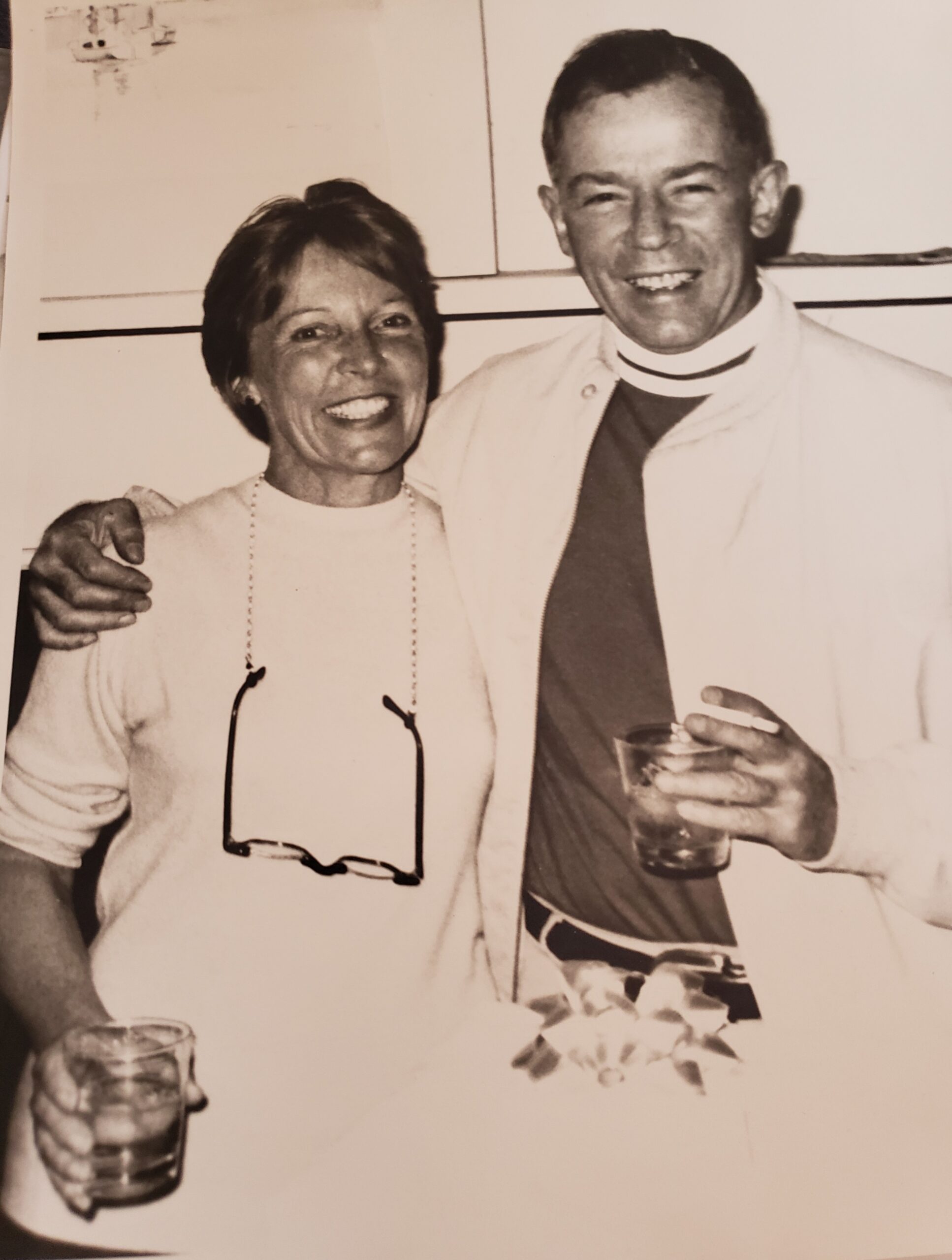
Lorna & Bill Trauth, Sr – 30th Wedding Anniversary held by Wild Goose Camp Staffers – June 29, 1970
(Photo courtesy of Deb Trauth Heidt)
*
Lorna Trauth put her story of Wild Goose Camp for Boys in writing with many details and stories of the camp’s history over the years.
*
Wild Goose Camp for Boys
By Lorna Trauth | Abridged by Annette Veelenturf
“Bill and I purchased the Wild Goose Club in 1955, after many fruitless attempts to find a suitable site for a boy’s camp. There was an indescribable magic to the place, which remains to this day. Bill, who was on the faculty of The Buckley School in New York City, had the summers off. We had spent thirteen summers working at other camps in New Hampshire, New York and Pennsylvania and had dreamt of founding our own camp and spent every free moment looking for a suitable site we could afford.
We tramped through thick woods, across open fields, up mountains and along soggy river banks to see various eastern states seeking our dream place, but met with disappointment at every turn. Sometimes, a railroad or heavily traveled road wound around or through the property and other times the Real Estate Agent’s promise of a “Scenic Lake” turned out to be a muddy pond or the “Well Constructed Main Lodge” but a tumbledown building fit only for rodents and bats.
After managing camps for so many years, Bill had developed a strong philosophy of what a good camp should offer its young charges in order to guarantee a worry-free summer for the parents and a rewarding experience for a young boy away from home and family. We often talked privately about establishing what we referred to as “The Best Camp in the World!” It became increasingly discouraging and frustrating not to find the right place.
As the summer of 1955 drew to a close, our spirits were very low. Although reluctant to admit it to one another, we had just about given up hope. Then, one day while thumbing through a pile of real estate clippings we had accumulated, I came across one that we had been relegating to the bottom of the heap for some time. Contrary to the exaggerated descriptions of most of the ads, this one read simply:
*
“For Sale: Former Fishing and Hunting Camp on Lake in the Maine Wilderness
1000 acres. Huge, Back-to-Back Fireplace in the Main Lodge.”
*
It was on one of those incredibly clear, sparkling Maine afternoons in mid-August that I first set eyes on the grounds of the Wild Goose Club. Towering pines and stately oaks shaded the spacious, neatly mowed lawns stretching down to the sandy shore of a sheltered cove, where gentle rippling waters reflected the blue of the sky. Beyond, could be seen Great Moose Lake with its shimmering white caps.
The owners, Mr. And Mrs. Edward Hayward, greeted me graciously and invited me into Castle Harmony for a tour of the building. At the entrance, in a gold frame where it remains to this day, hung the poem:
*
“Here on the shores of this wild lovely lake
Where nature all her prospects richly blend
Has met for years (What memories awake!)
A choice Companionship of genial friends”
*
They pointed out the original poker table in the Library, the handsome gilt framed oil portraits of the members of the CIub and the many framed photographs and documents in the dining room, where once the original “Ganders” were served their sumptuous meals.
The Haywards had made every attempt to preserve the Club as it had been in the former days. The pot-bellied stoves, firemen’s beds, old light fixtures, elaborate bar, butter churn, leather bound books on the library shelves and other memorabilia of bygone days were still in evidence; only the kitchen had been updated.
I was taken on a tour of the other buildings. Old harnesses, bridles and reins still hung on hooks in the barn. The three-hole outhouse, the woodshed and the icehouse were still standing. Castle Harmony, Sleepy Hollow and the Boathouse, with their sharply slanting metal roofs were in excellent condition, white paint glistening in the sunshine, set off by dark red trim on doors and windows, as they had always been and remain today.
Heading out of the Port of Galashiels with Mrs. Smith, one of the Hayward’s daughters, at the helm of a small motor boat, I spotted the steel structure of the famed Lighthouse rising above the pines. Beyond lay a stretch of marshy land interspersed with lily padded inlets, one of which led to the entrance of Higgins Stream. This pristine area resembled the Florida Everglades with its twisting waterways, edged with cattails, water hyacinths and marsh grasses; a natural habitat for beaver, muskrat and a variety of wild birds.
A Great Blue Heron swept majestically skyward from its hidden resting-place and disappeared from view across the lake where we spotted a family of loons. Emerging onto Great Moose Lake, I was treated to the sight of three wide, sandy beaches which bordered the mile long stretch of wooded shoreline to the east of the cove. Beyond the third beach a large boulder which marked the end of the property named “French’s Rock” in honor of William E. French, who became a member in 1873.
Turning back into the cove, we followed Mainstream’s gently winding path behind the Boathouse north for almost a mile where we disembarked. As we hiked up along the river’s steep bank we could hear the thundering rush of water from the upper lake as it came tumbling over the large rocks in the river where a dam once stood. A short distance beyond lay the calm waters of Lake Como with its wooded shoreline. A nature lover’s paradise!
When Bill returned with me the following week his reaction was similar to mine but we felt sure we could never afford such a place. With his family now grown and his health failing, Mr. Hayward reluctantly decided to sell it. Paper companies had been eager to buy the property, but he had refused all offers, not wanting the land he so loved and valued to be used for such a purpose.
Finally, he asked Bill point blank how much he could offer him. With only a moment’s hesitation Ed accepted, explaining that he had already discussed the matter with his family and they had agreed that it was an ideal way for him to fulfill his dreams as well as put the land to a worthwhile purpose. He had only one stipulation. He wanted us to assure him that he and his family could come visit us every summer to see the camp in action and watch the boys enjoying the facilities. The Haywards visited us for a number of summers and in later years his daughters and their children returned from time to time.
That fall, work began to convert what had been almost a century ago a renowned and exclusive retreat for Boston tycoons into what we hoped would prove to be a renowned and unique camp for boys. Land was cleared for a ball field; a tennis court was built, a well drilled, and new septic, plumbing and electrical systems were installed to accommodate at least 150 people.
Sleepy Hollow was converted into a spacious Craft Shop, washrooms, and First Aid room, downstairs. The upstairs rooms were used to house camp counselors. The rooms above the Boathouse became additional boys’ sleeping quarters: other campers took over the converted wood shed.
In the spring, docks, ramps and floats were built, painted and put in place, and renovations to buildings completed. Trucks laden with boats, rifles, tents and other sports equipment, as well as kitchen appliances and furniture for the dining room, office, infirmary and sleeping cabins rumbled up the camp road which once the horses and elegant carriages of the members of the Wild Goose Club had traveled.
Finally, on June 27, 1956 twenty-nine boys ages nine to thirteen, lugging fishing rods, knapsacks, tennis rackets and camera, headed for the cabins they would be calling home for the next eight weeks.
The first summer, activities were limited to horseback riding, swimming, boating, tennis, crafts, fishing, archery, softball, badminton and croquet. Long hikes and boating expeditions to explore the surrounding area were a large part of the program, and a spirit of adventure pervaded every moment of that memorable summer.
As the years passed and enrollment grew to the usual complement of sixty-five boys, five sleeping cabins were added. In later years the program was expanded to include mountain climbing, canoe trips, baseball, water skiing, soccer, lacrosse, wrestling, windsurfing, football and photography.
As our reputation spread by word-of-mouth, applications were received from all parts of the United States, Canada, Europe, Central and South America and Asia. Our basic philosophy in founding the camp was stated in the following opening paragraph of the “Operational Procedure”, a thirty-two page document which served as a guide to our staff.
*
“Health, safety and a wholesome environment must take precedence over all other considerations.”
*
This document also covered every aspect of camp, including the program, discipline, safety rules, counselor responsibilities and detailed procedures for supervising and coaching each sport or camp activity.
In an era when permissiveness and the lowering of standards were becoming commonplace, we continued to stress courtesy, pride in a job well done, regard for others, good sportsmanship, appreciation of the environment, responsibility and other traditional and ethical values to our campers and staff.
We kept our standards high, at the same time encouraging a spirit of freedom, fun and adventure. Boys who had attended Wild Goose for as short a time as one summer would often explain to a new camper who questioned the few rules, “Well, it’s just not the Wild Goose Way!”
The ‘Wild Goose Way’ proved to be highly successful as over 1,000 boys spent from one to six summers “On the shores of this wild, lovely lake amongst a choice of Companionship of genial friends.”
In October of 1971, Bill, known affectionately as “The Commodore”, passed away suddenly of a heart attack. Our son, Bill Trauth, Jr, following in his father’s footsteps, became Director of Wild Goose. He and I continued to manage the camp together for the next twenty-five years.
Following a very successful 1995 camp season, we announced the closing of Wild Goose Camp for Boys. The many letters and telephone calls received from parents, campers and staff around the world, expressing their sadness at the closing of the camp and their appreciation for having been a part of Wild Goose, was overwhelming.
Many residents of Harmony and the surrounding towns, whose names are too numerous to mention, contributed greatly to the success of the camp. Few of these deserve special recognition from Harmony; Clyde Bemis, the Huffs, (Emma substituted in the kitchen on the cooks’ days off), John and Tracy Morrison, who serviced our vehicles and motor equipment, Onie and Marie Lougee, who more recently have taken excellent care of our property winter and summer.
A successful camp depends in great part on the quality of the meals. We were indeed fortunate to have as our cook Elsie (Baird) Vining of St. Albans. Three years later, Elsie remarried to Lyndon Kinney, an experienced chef who grew up in Ellsworth, so we were doubly blessed. The Kinneys, who became known by campers and staff as “The Best Cooks in Maine”, remained with us for over 30 years. We are grateful to them all and to our Harmony neighbors who have been so helpful and supportive of our family and the camp over the years.”
Lorna also noted in a 2002 interview some of the many recognizable families who sent their boys to camp. “Humphrey Bogart sent his son there. Also the Rockefellers and Vanderbilts sent their boys to Wild Goose. Our reputation grew, not through advertising but by word of mouth.”
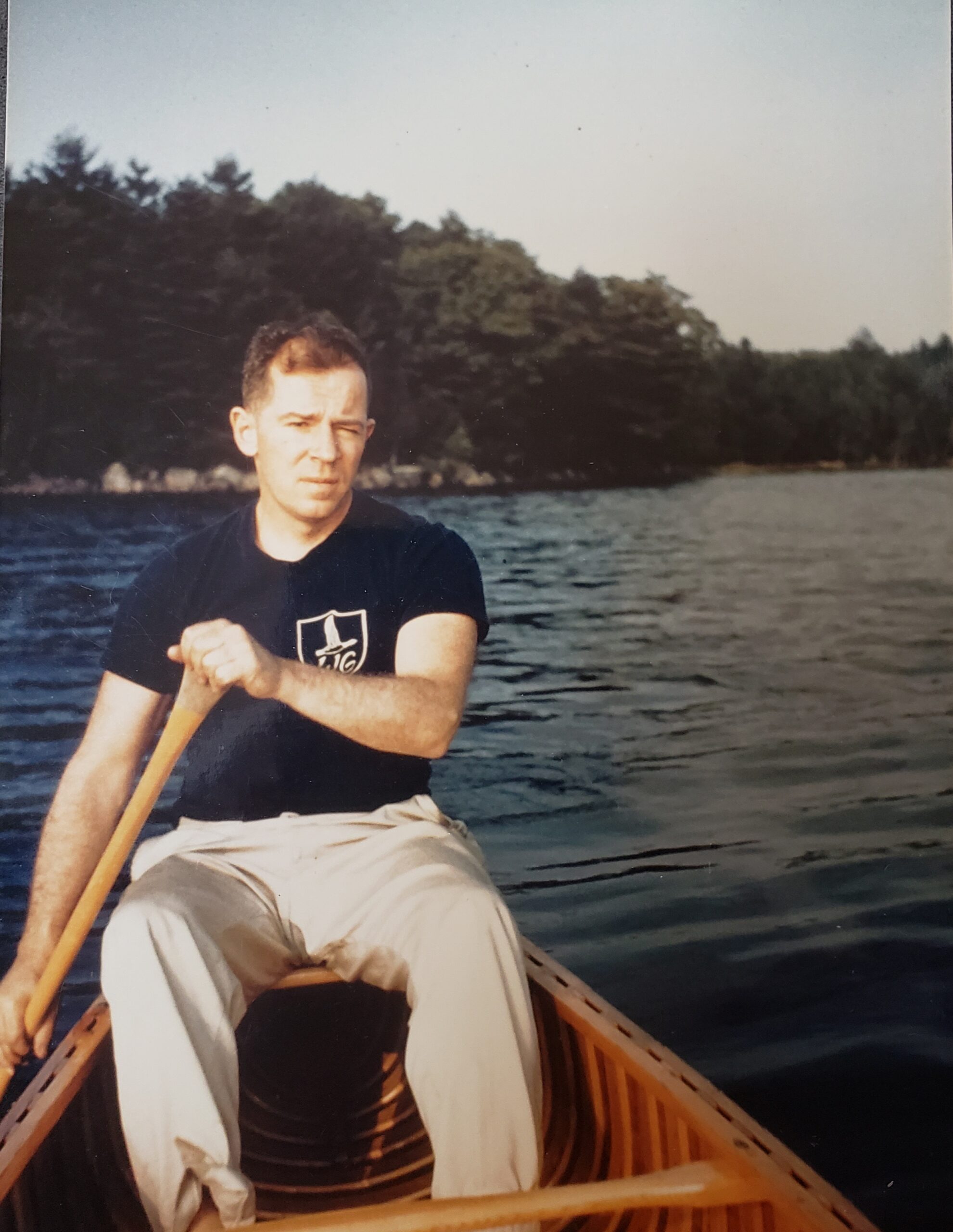
“The Commodore” | William E. Trauth, Sr | Wild Goose Camp for Boys
(Photo courtesy of Deb Trauth Heidt)
*
William “Billy” E. Trauth, Jr was Director of Wild Goose Camp for Boys from 1972 to 1995, guiding hundreds of young boys to enjoy a fun filled camp summer, like his father had before him.
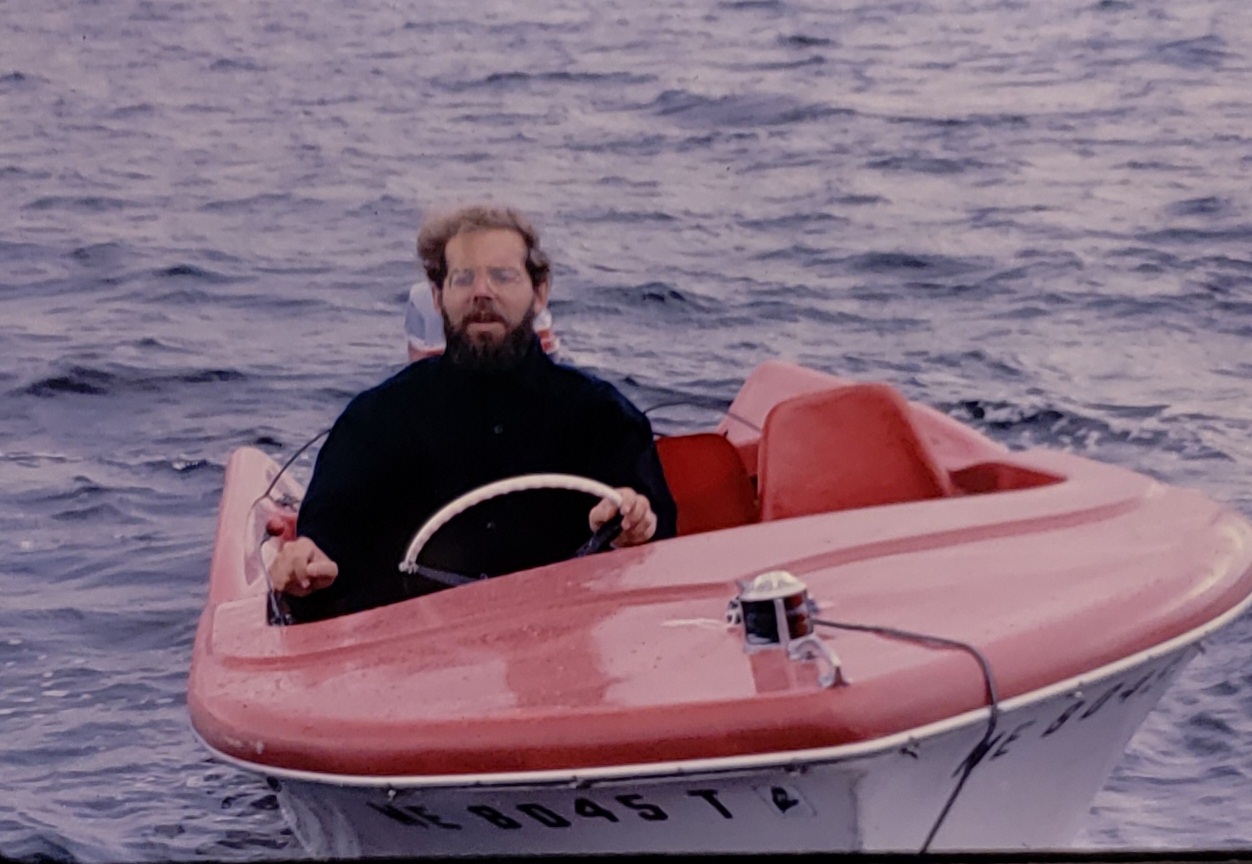
William E. Trauth, Jr | Wild Goose Camp for Boys
(Photo courtesy of Deb Trauth Heidt)
*
Much of the information below of the function and name origins of the buildings was compiled from a post in a 2009 Wild Goose Camp for Boys Wikimapia thread by an unknown contributor using the name “harmonygirl” to whom we are grateful for the many details she provided. In 2024, Bill & Lorna’s daughter Deb (Trauth) Heidt graciously shared a number of photos of the buildings & grounds where she spent many summers since the camp opened in 1956 and are included with the descriptions below.
*
William Trauth, Sr had a miniature Wild Goose uniform made for 3 year old Debbie Trauth in 1956, the first summer the camp operated.
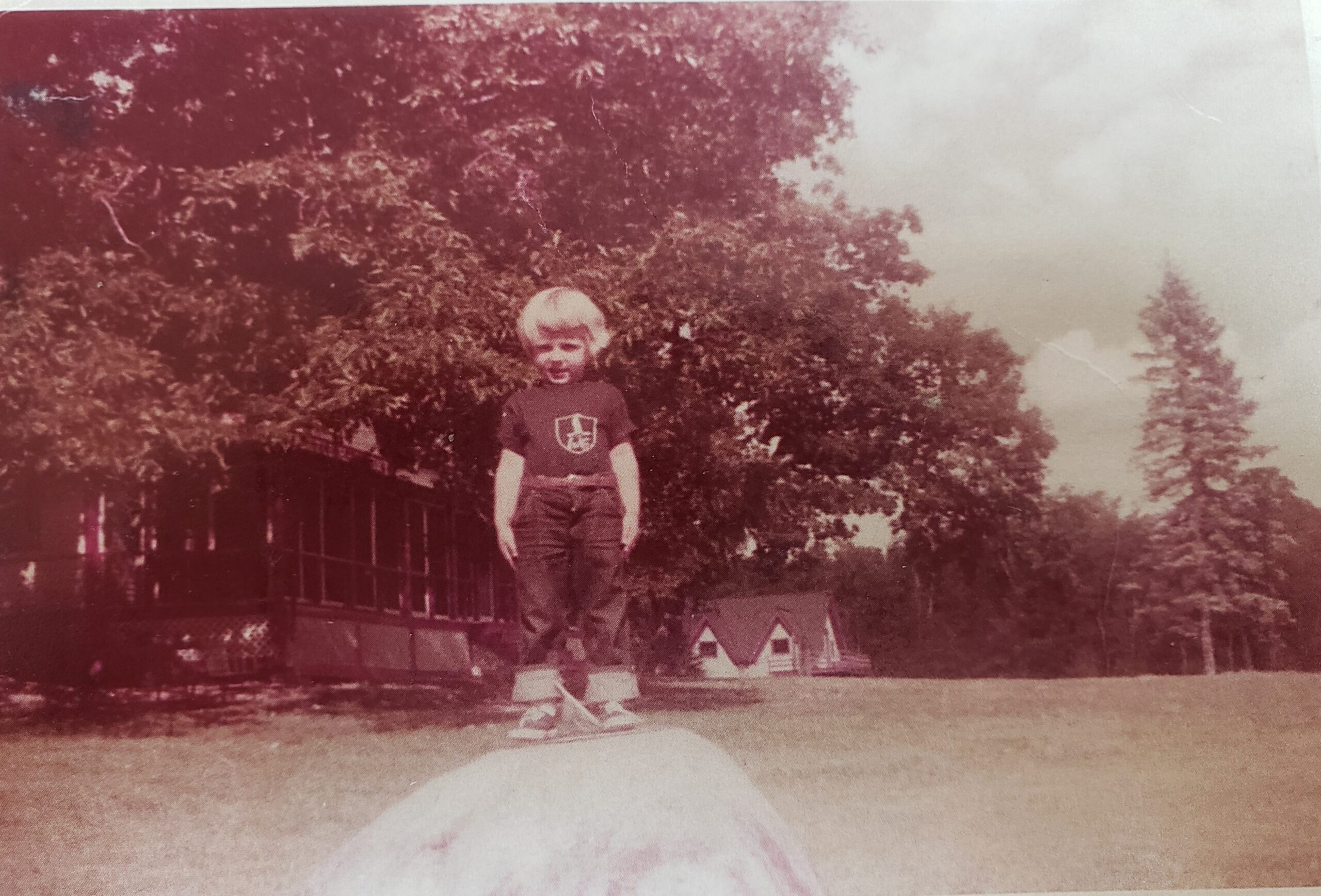
Deb Trauth at Wild Goose Camp for Boys in front of Castle Harmony with the Boat House in background
(Photo courtesy of Deb Trauth Heidt)
*
When the Trauths purchased the compound in 1955, there were 6 buildings still standing from its Wild Goose Club days including the Castle Harmony Main Lodge, Sleepy Hollow Guest Lodge, Horse Barn, Carriage House, Boat House and a Wood Shed as they had been previously designated.
*
“Castle Harmony” remained as the main lodge and retained its original Wild Goose Club name. It had a library, dining room, restaurant sized kitchen, office and a shed with washers & dryers. Two large walk-in rooms, which were originally used by Wild Goose Club members to store ice from the lake, were converted into storage rooms for camping gear and used as headquarters to prepare for various camping trips and became known as “The Trip Rooms”.
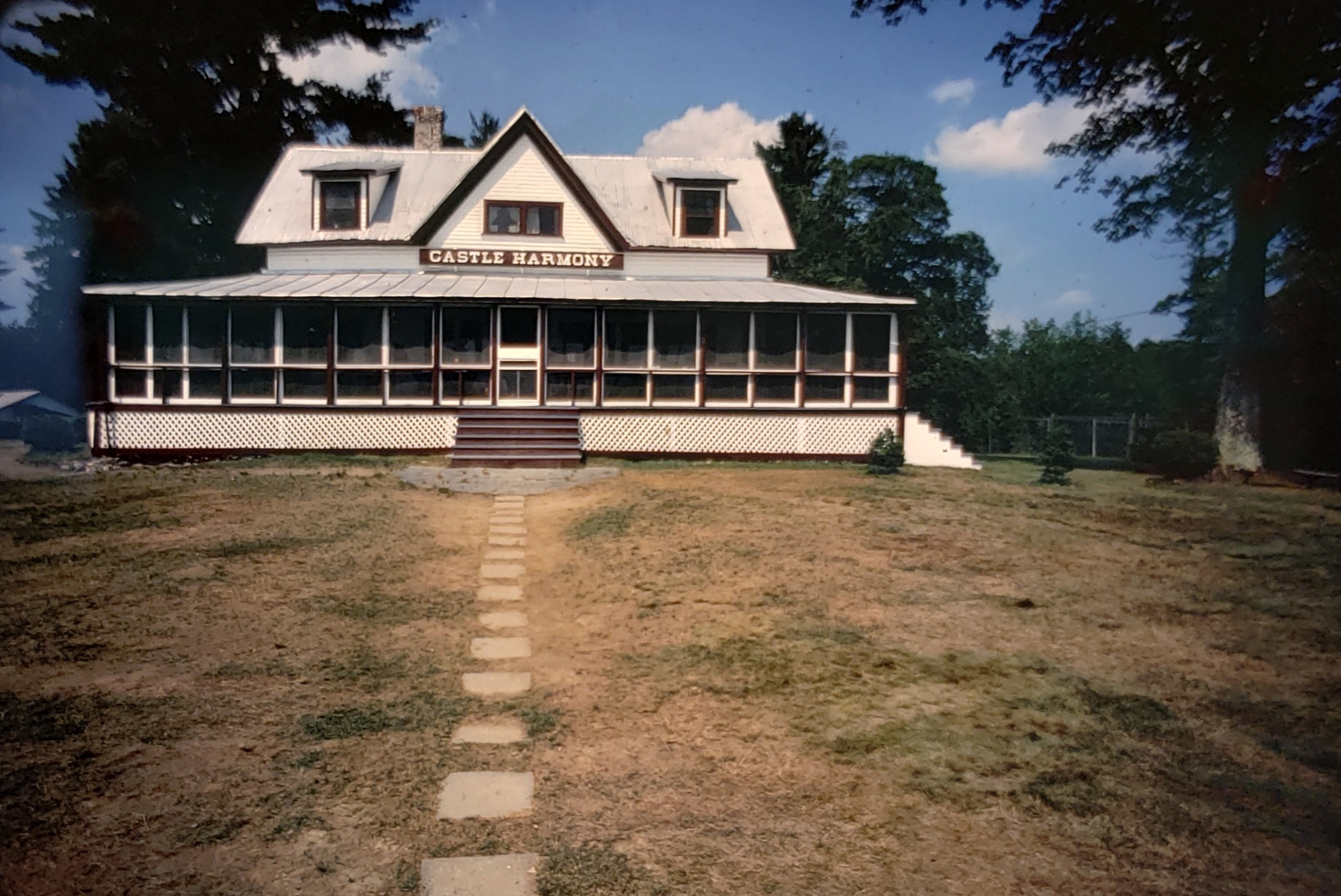
Castle Harmony | Wild Goose Camp for Boys
(Photo courtesy of Deb Trauth Heidt)
*
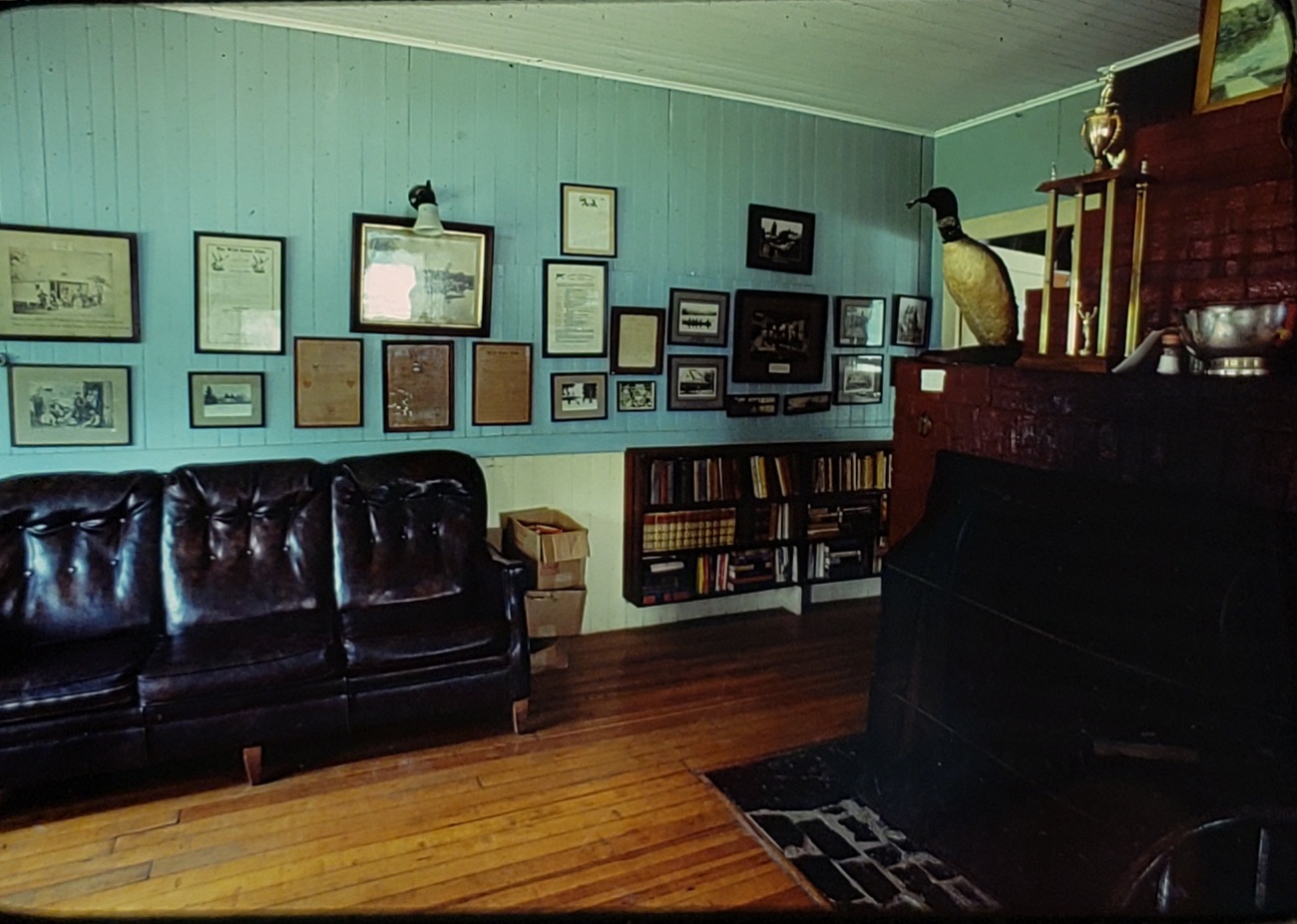
Library at Castle Harmony | Wild Goose Camp for Boys
(Photo courtesy of Deb Trauth Heidt)
*
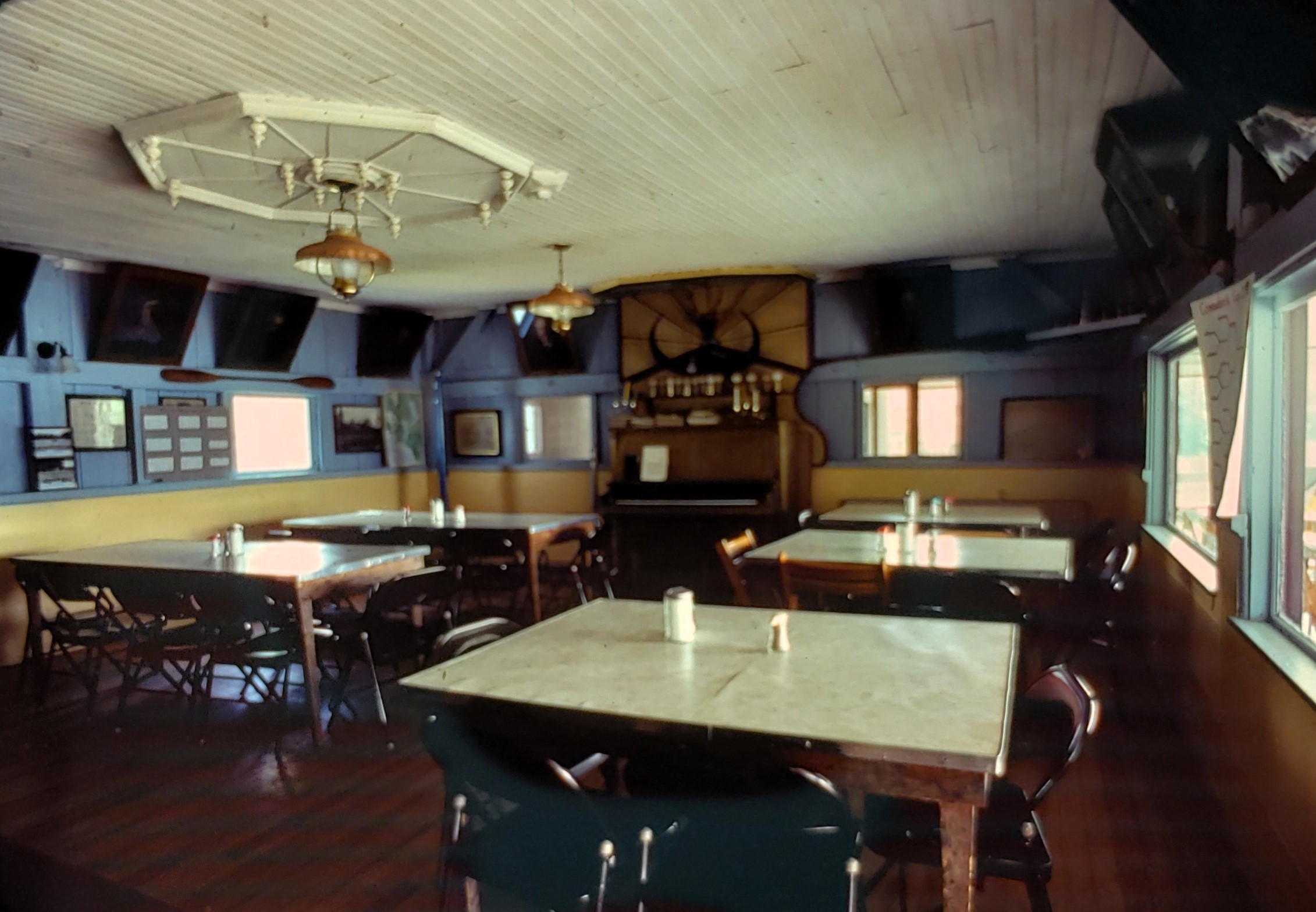
Dining Hall at Castle Harmony | Wild Goose Camp for Boys
(Photo courtesy of Deb Trauth Heidt)
*
“Sleepy Hollow” was converted from a guest lodge into washrooms and a craft shop downstairs and also retained its original Wild Goose Club name. The upstairs was used at various times as a sleeping cabin, dark room and science lab.
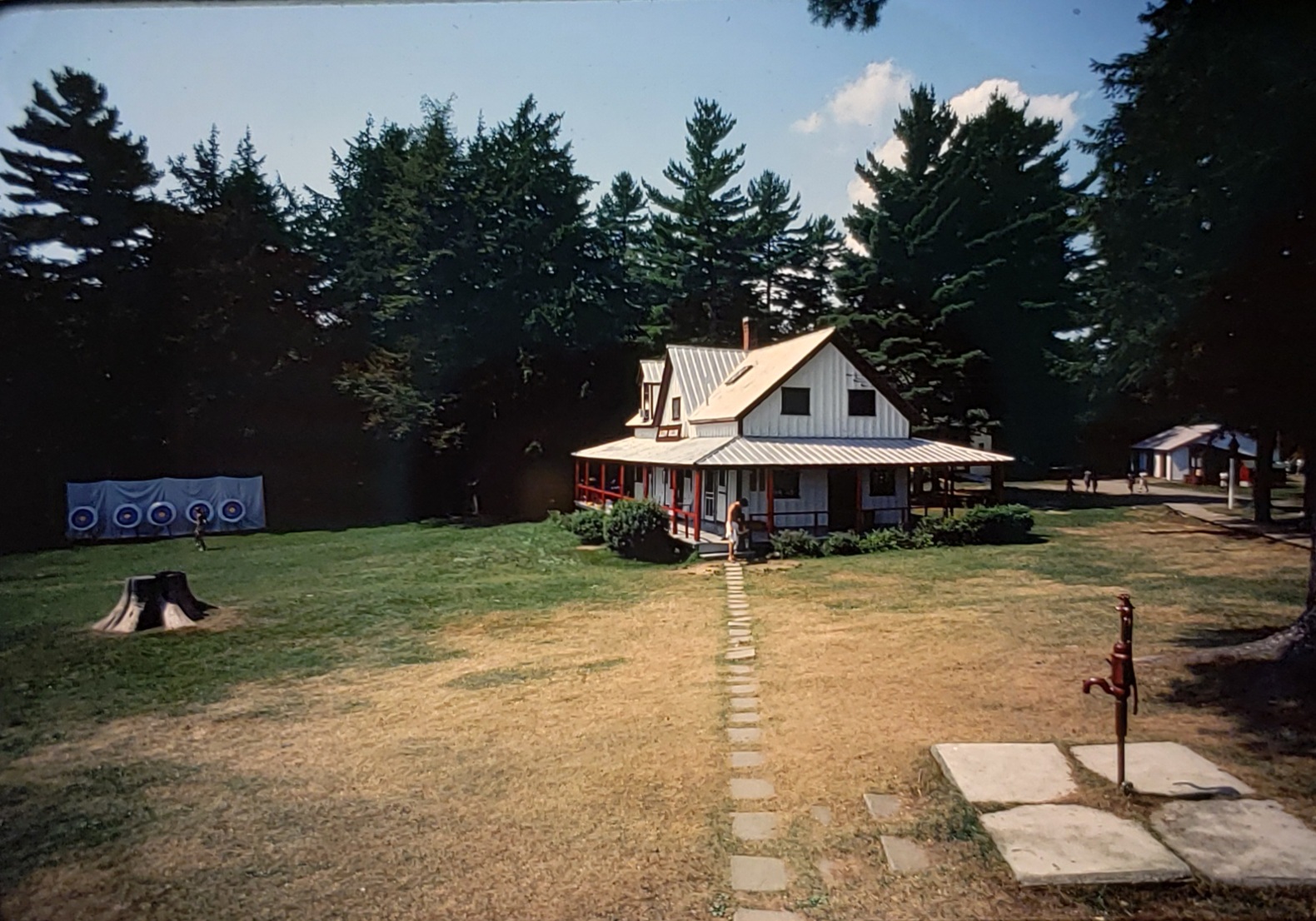
Sleepy Hollow | Wild Goose Camp for Boys
(Photo courtesy of Deb Trauth Heidt)
*
The Horse Barn was converted into an indoor recreation area and renamed by Commodore Trauth as “Innisfail” with pool tables, shuffleboard and ping pong downstairs and a weight room and movie theater upstairs.
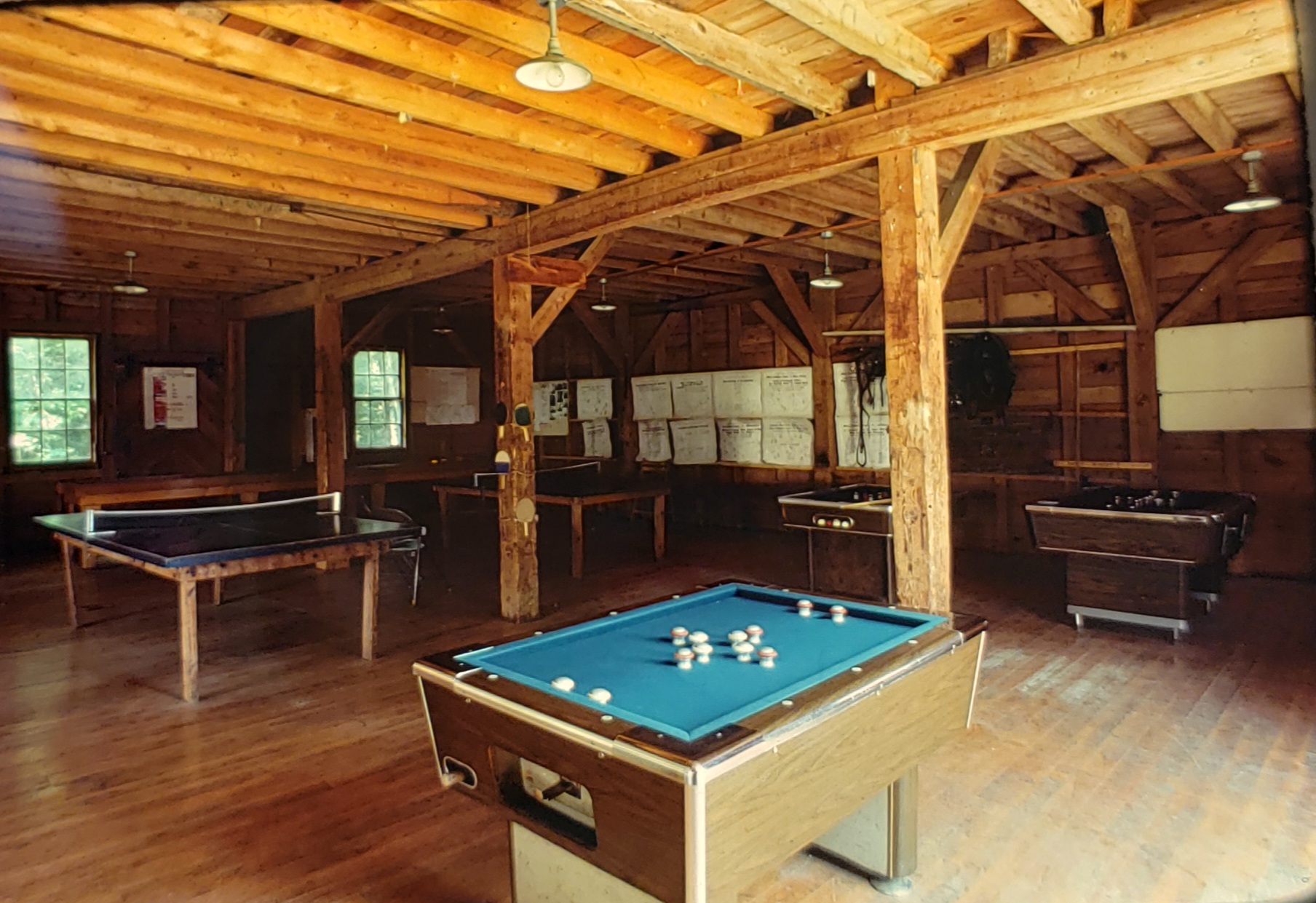
Innisfail Recreation Hall | Wild Goose Camp for Boys
(Photo courtesy of Deb Trauth Heidt)
*
“The Carriage House” was used by the camp for extra storage of vehicles and baseball equipment. Part of it was also used as the Commodore’s Paint Shed. Some of the Wild Goose Club’s original horse drawn carriages and sleighs came with the property and were later sold off.
*
“The Boat House” was used by the camp to store their numerous canoes, rowboats, motor boats and ski boats during the winter. It came with several antique Dore style boats leftover from the club. During the summer the space was used for changing into swimsuits and each boy had a hook with his name on it for his clothes/bathing suit. Upstairs was the Camp Cook’s apartment. Lyndon & Elsie (Baird) Kinney were the camp cooks for most of the years of the camp serving for over 30 years. The Commodore called them the best cooks in the world.
*
By the time it became The Wild Goose Camp for Boys, the interior of the Castle Harmony Main Lodge had changed very little since its original construction. Many of the old portraits of early Wild Goose Club Members remained hung and were enjoyed by hundreds of boys who attended the camp over a 40 year period. Newer pictures with boys who attended camp over the summers were added over the years.
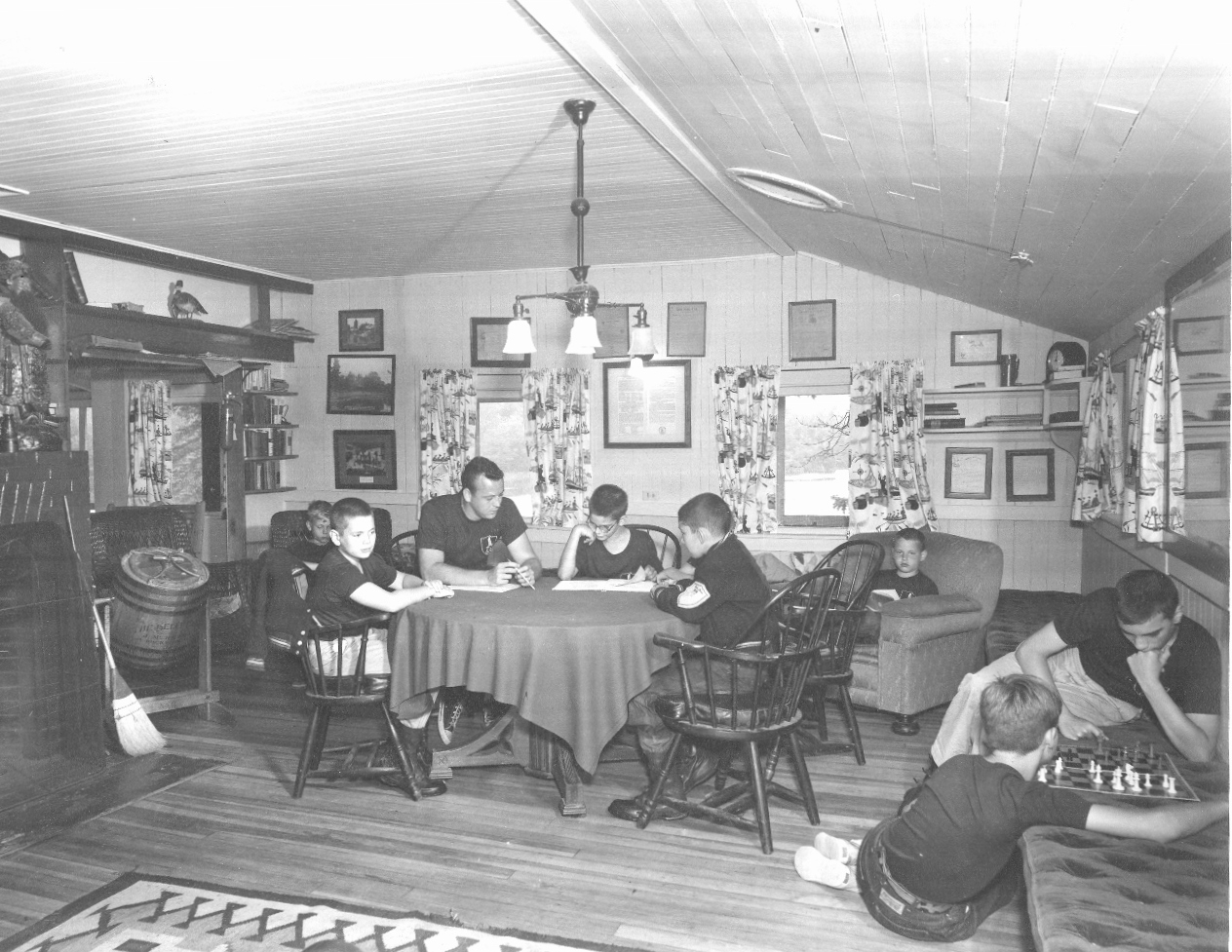
Wild Goose Campers in the Library at Castle Harmony gathered around the now familiar, albeit former, poker table
*
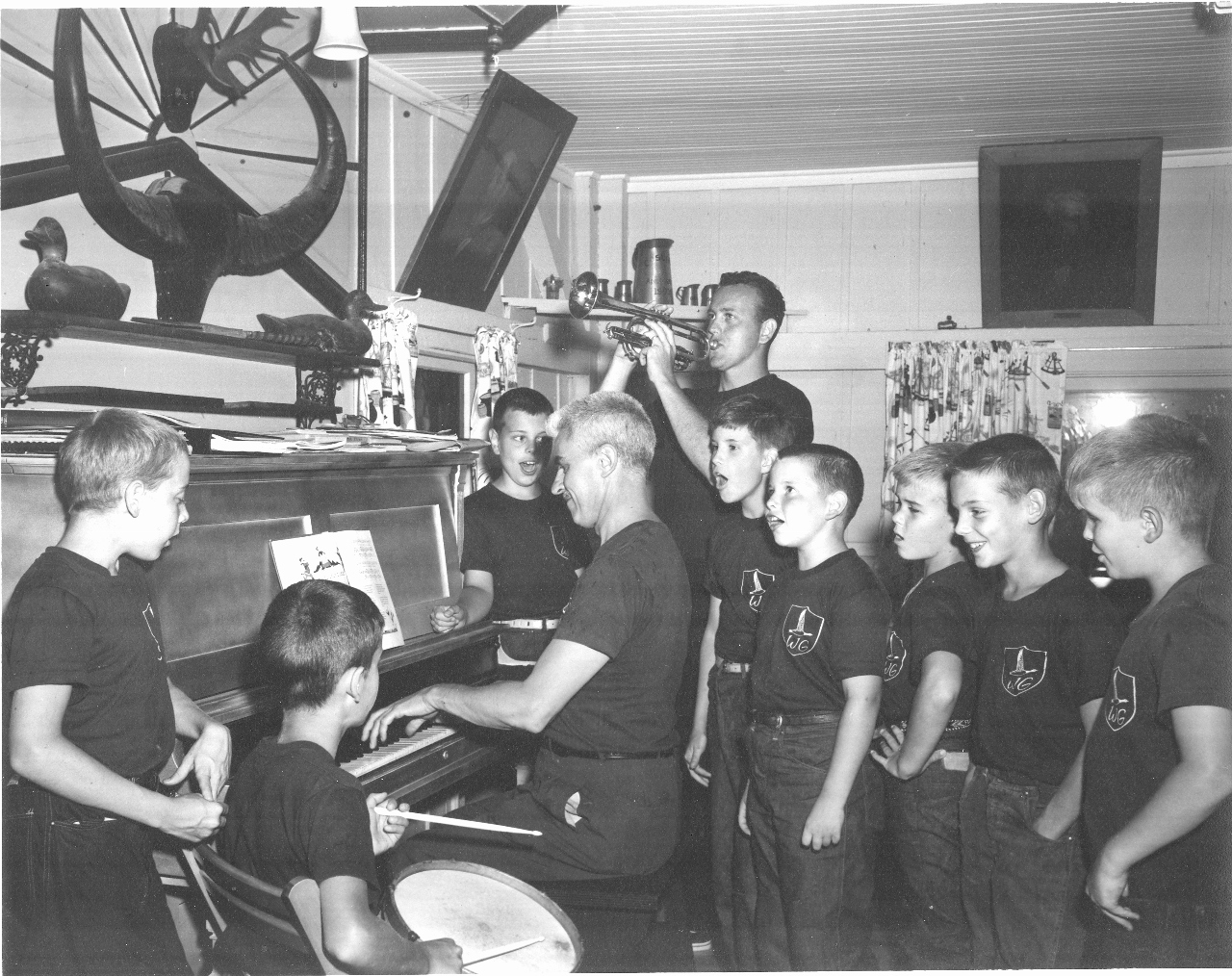
Wild Goose Campers join in a Sing-a-Long in the Library at Castle Harmony
*
The boy’s lodging cabins were all named by Commodore Trauth who also hand painted all the signs for the buildings in Old English lettering style. Bill had studied at the Art Students League in New York City and was a commercial artist before becoming a school teacher and coach at the Buckley School in New York.
*
“Cambridge Hinge Tube & Chaplet Works” was known at camp as Cambridge. It was the original Wild Goose Club Fire Wood Shed converted into lodging and renamed for a business in Cambridge, New York.
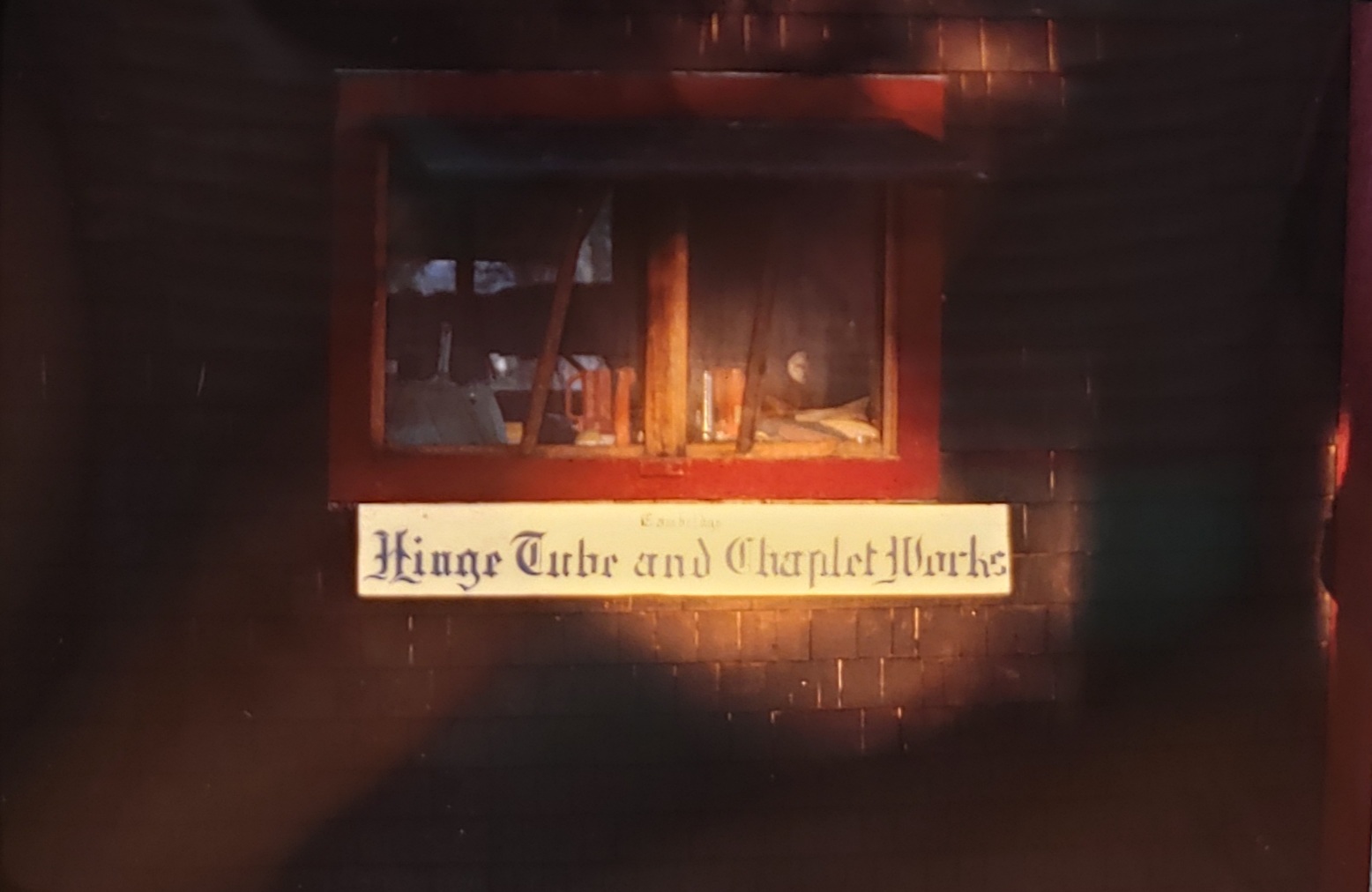
Cambridge Lodging Cabin | Wild Goose Camp for Boys
(Photo courtesy of Deb Trauth Heidt)
*
“Anaconda” was named for a poker game played by Camp Counselors after the boys were in bed.
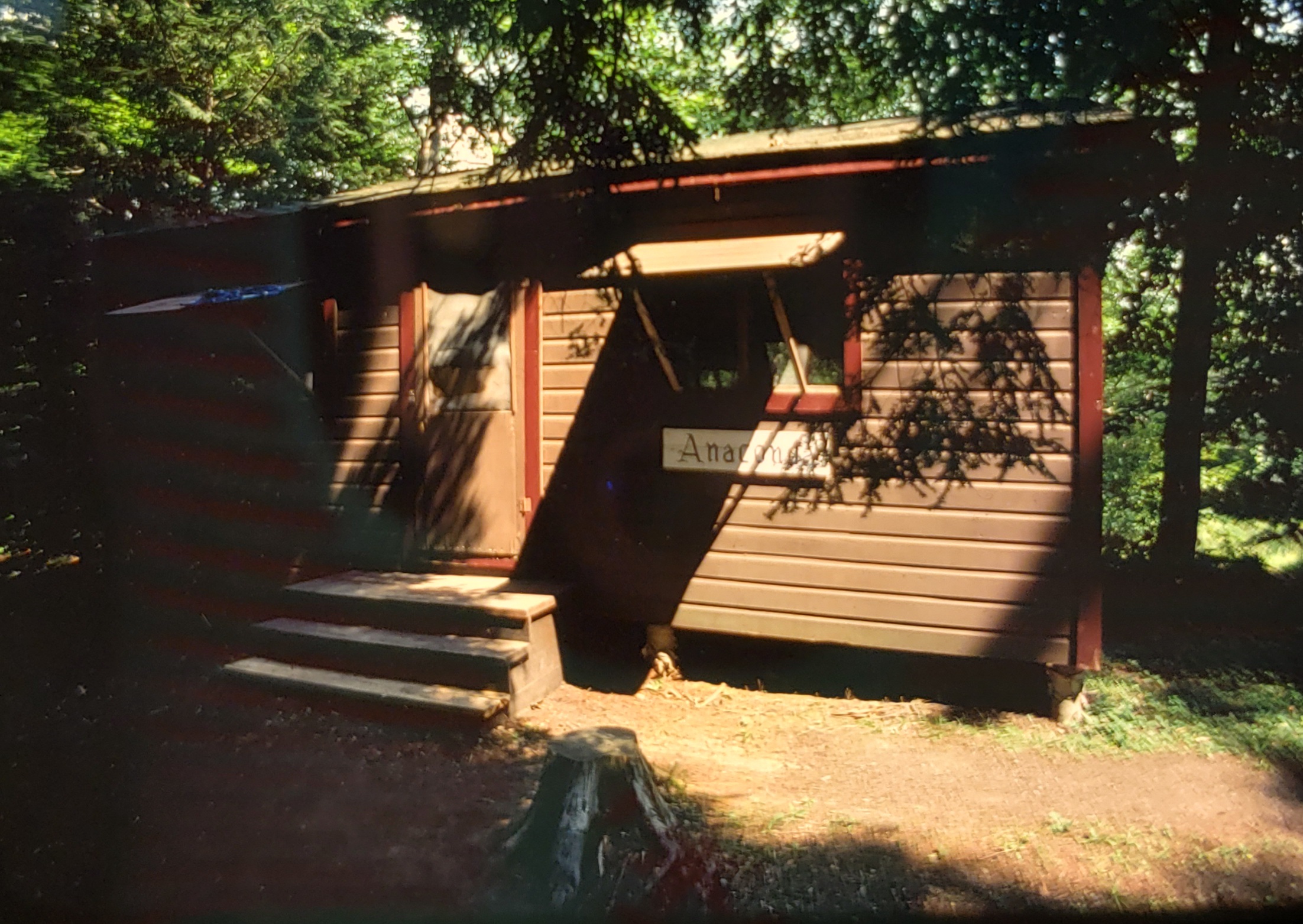
Anaconda Lodging Cabin | Wild Goose Camp for Boys
(Photo courtesy of Deb Trauth Heidt)
*
“Old Sledge” was also named for a poker game played by the Counselors.
*
“Volney Qua” was named for the Caretaker of Camp Nassau in Cambridge, New York where Commodore Trauth had previously worked.
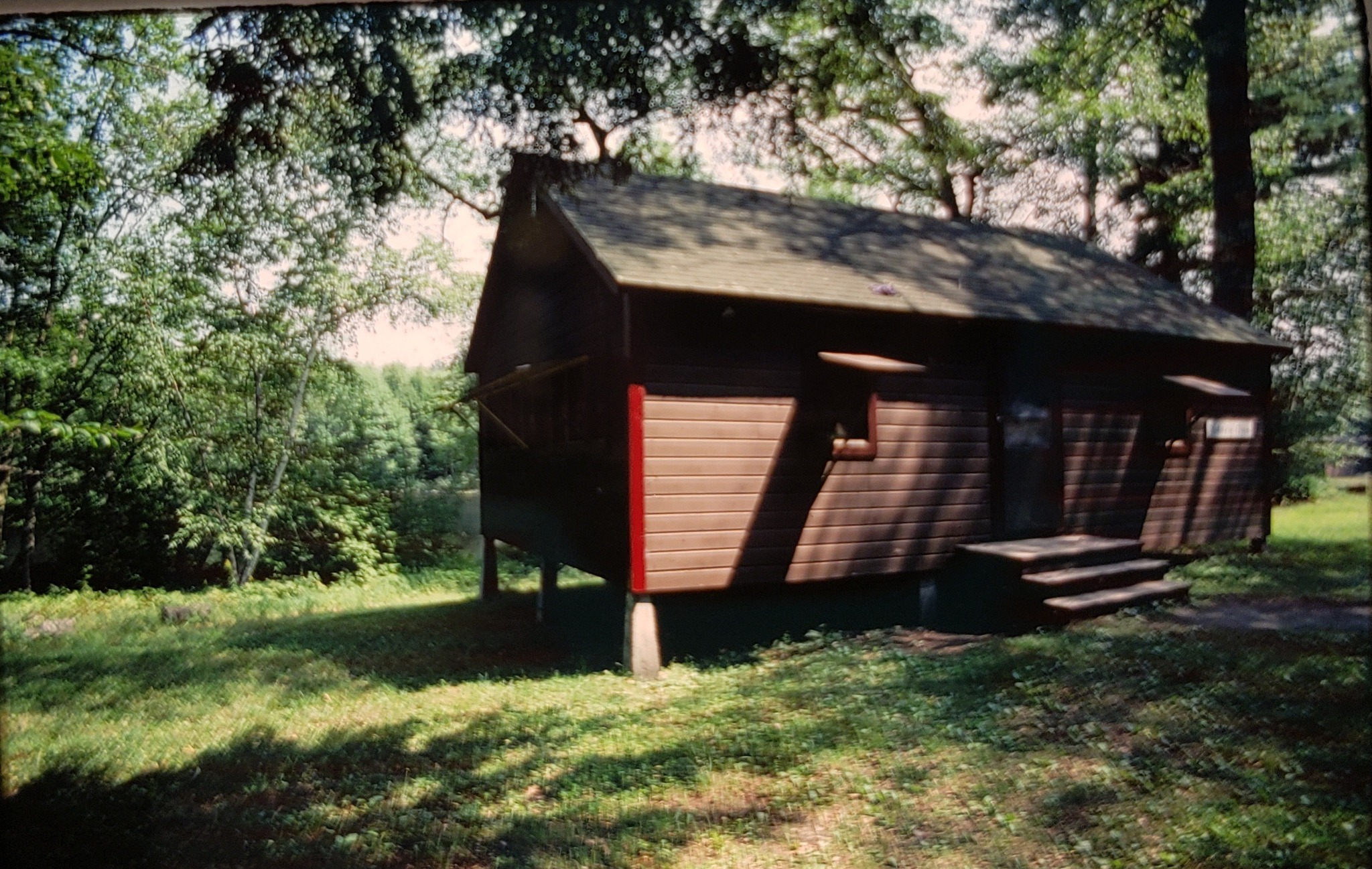
Volney Qua Lodging Cabin | Wild Goose Camp for Boys
(Photo courtesy of Deb Trauth Heidt)
*
“Port of Galashiels” was known at camp as Galashiels and named after the cove where the camp was located on the Main Stream Inlet of Great Moose Lake. The cove had been nicknamed as such by the original Wild Goose Club in recognition of founding member Archibald Linn’s former residence in Galashiels, Scotland.
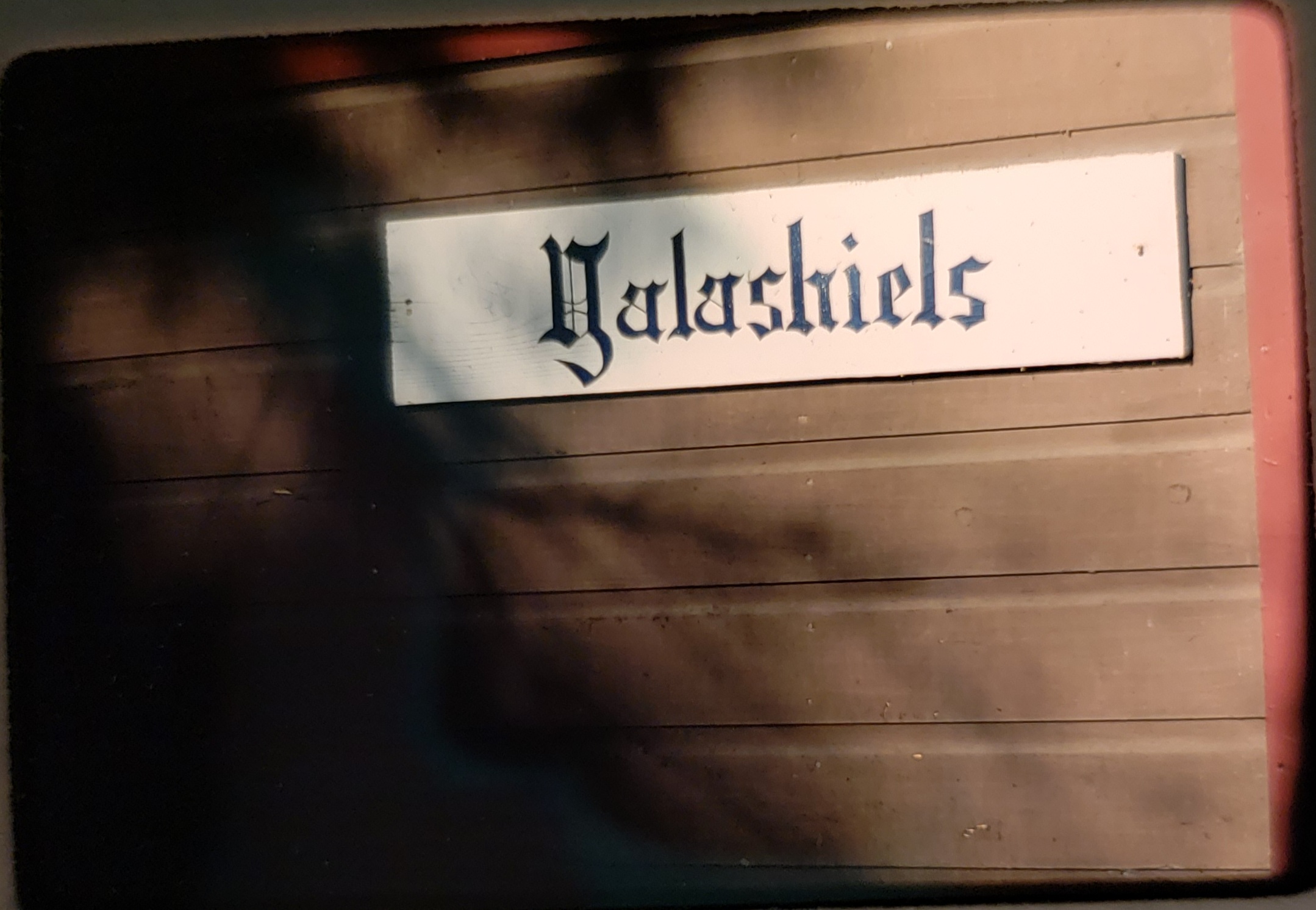
Galashiels Lodging Cabin | Wild Goose Camp for Boys
(Photo courtesy of Deb Trauth Heidt)
*
“Passel O’Yapes” was named for a line in the song ‘You Better Quit Kickin’ My Dog Around’ sung at camp sing-a-longs.
*
Some of the other buildings which had been built or renovated soon after the camp opened and named by The Commodore included:
“Bill Miller’s Riviera” was a roofed drying rack where wet towels were hung. It was named after a famous nightclub on the New Jersey Palisades close to where Commodore Trauth grew up.
*
“The Friendly Diner” had been an outhouse and was upgraded and converted into the camp store. Camp supplies such as batteries, bug dope (the store’s biggest seller), camp stationery (for the requisite Sunday letter home) and “Crusher” hats (rolled wool hats) could be bought and charged to the camper’s account. The Camp Store put out cookies and punch at the Camp Kitchen nightly before bedtime.
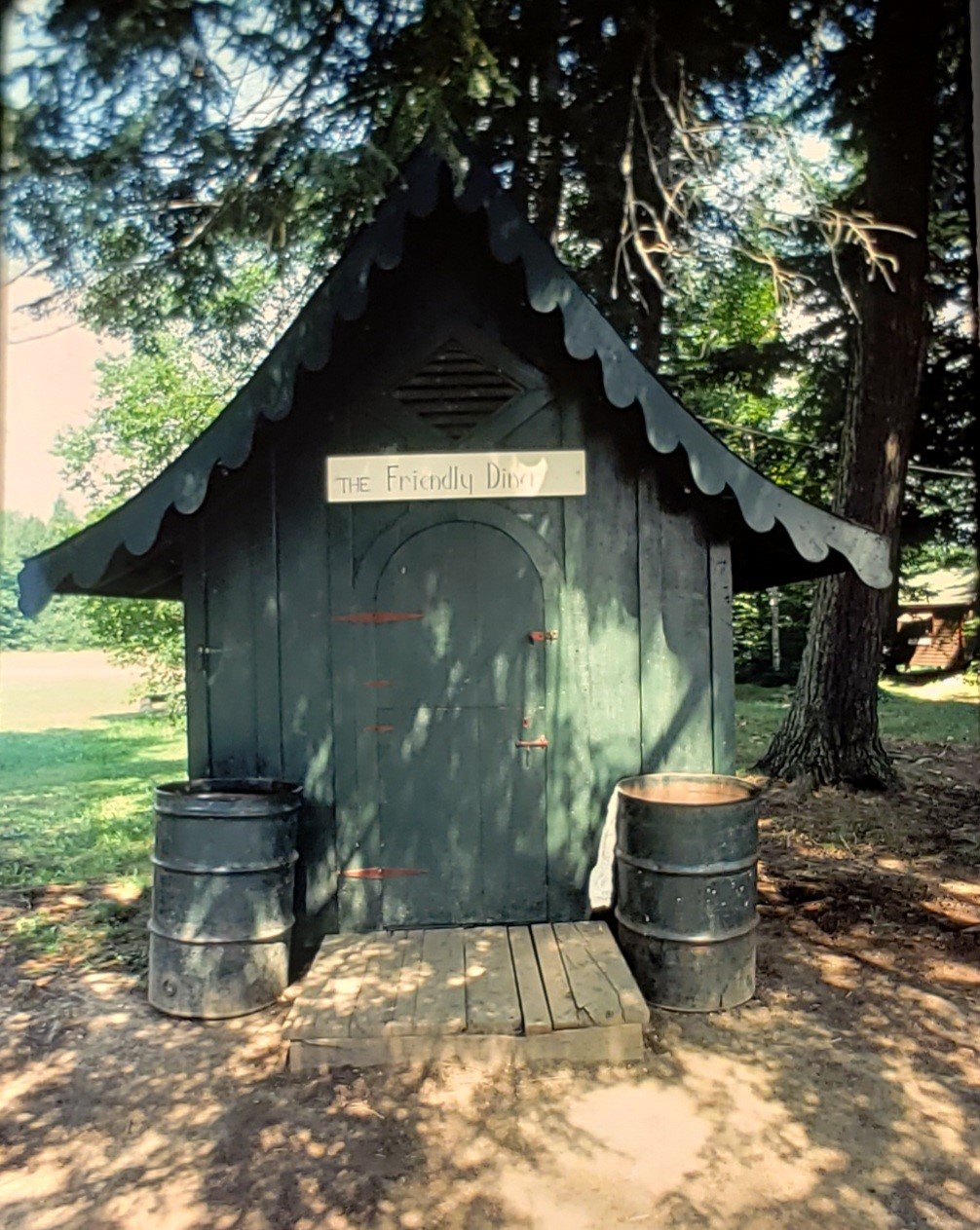
The Friendly Diner | Wild Goose Camp for Boys
(Photo courtesy of Deb Trauth Heidt)
*
“John C. Trauth Memorial Field” was a baseball field The Commodore cut from the thick woods and it was likely one of the best kept ballfields in the State of Maine at the time. Bill named it for his father who passed away in 1955 and had been a minor league ball player on the St. Paul’s 1904 team.
*
Sailing on Great Moose Lake was one of many popular activities for Wild Goose Campers.
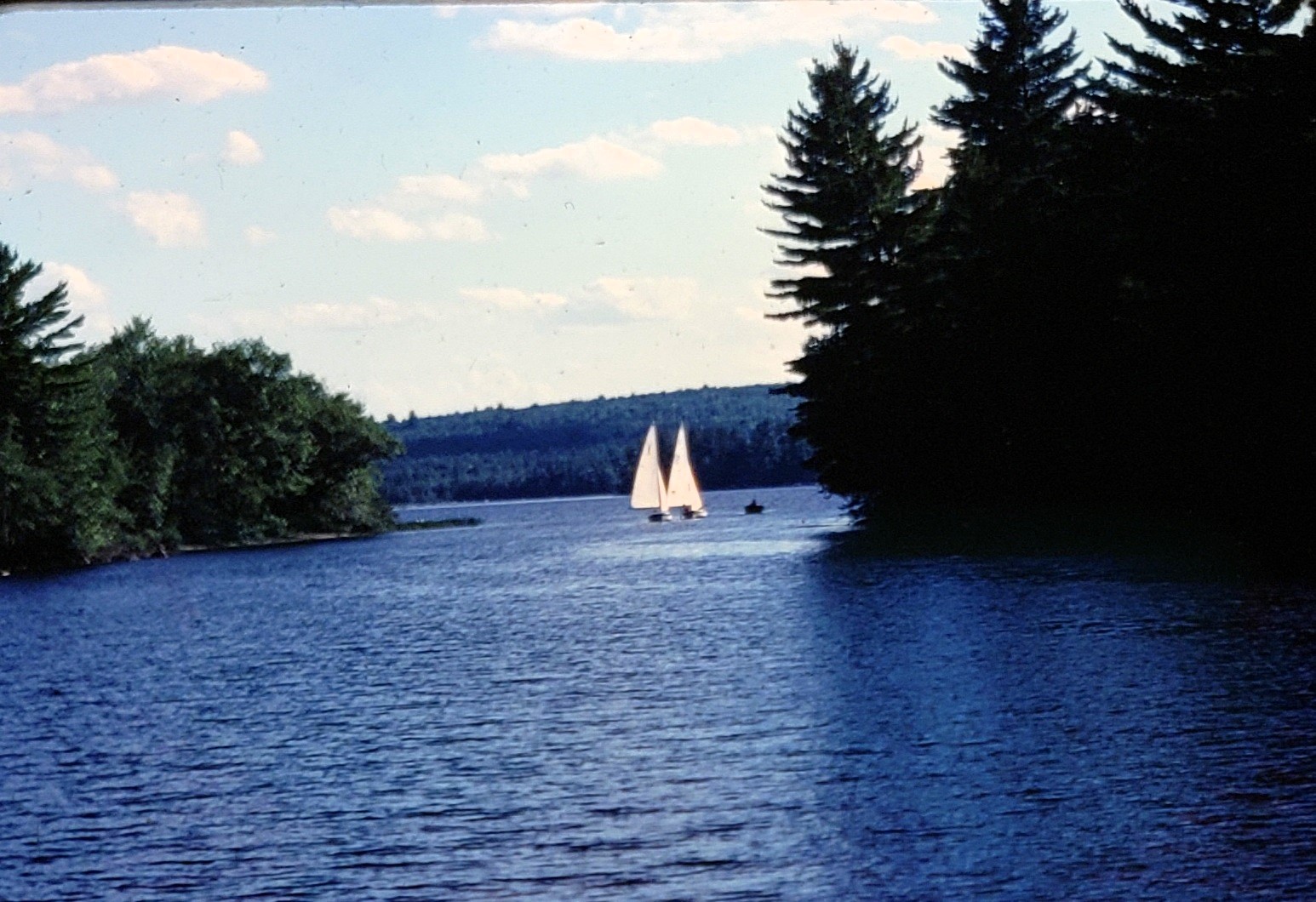
Wild Goose Campers navigating the Main Stream Inlet into Great Moose Lake
(Photo courtesy of Deb Trauth Heidt)
*
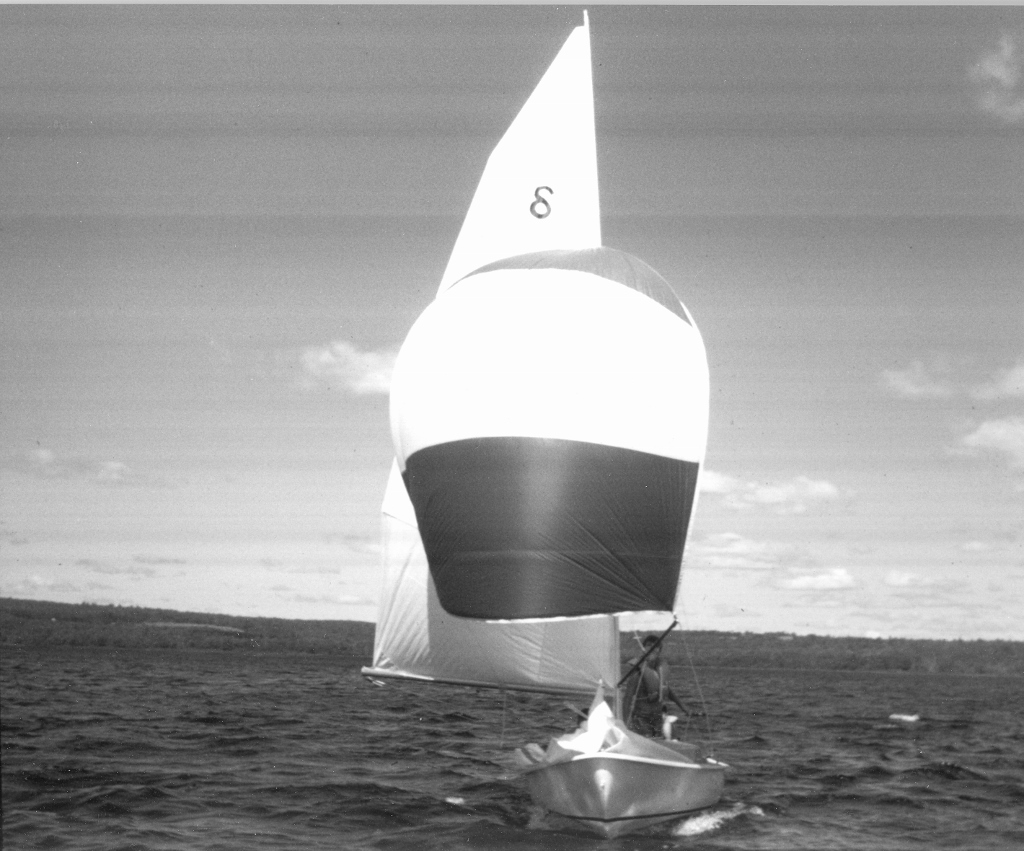
Catching a good wind on Great Moose Lake
*
The Wild Goose Camp for Boys closed for good at the end of the 1995 camping season and is now under private ownership. Castle Harmony remains standing today along the shores of Main Stream engaging curious visitors passing by on boats to ponder its long, proud heritage.
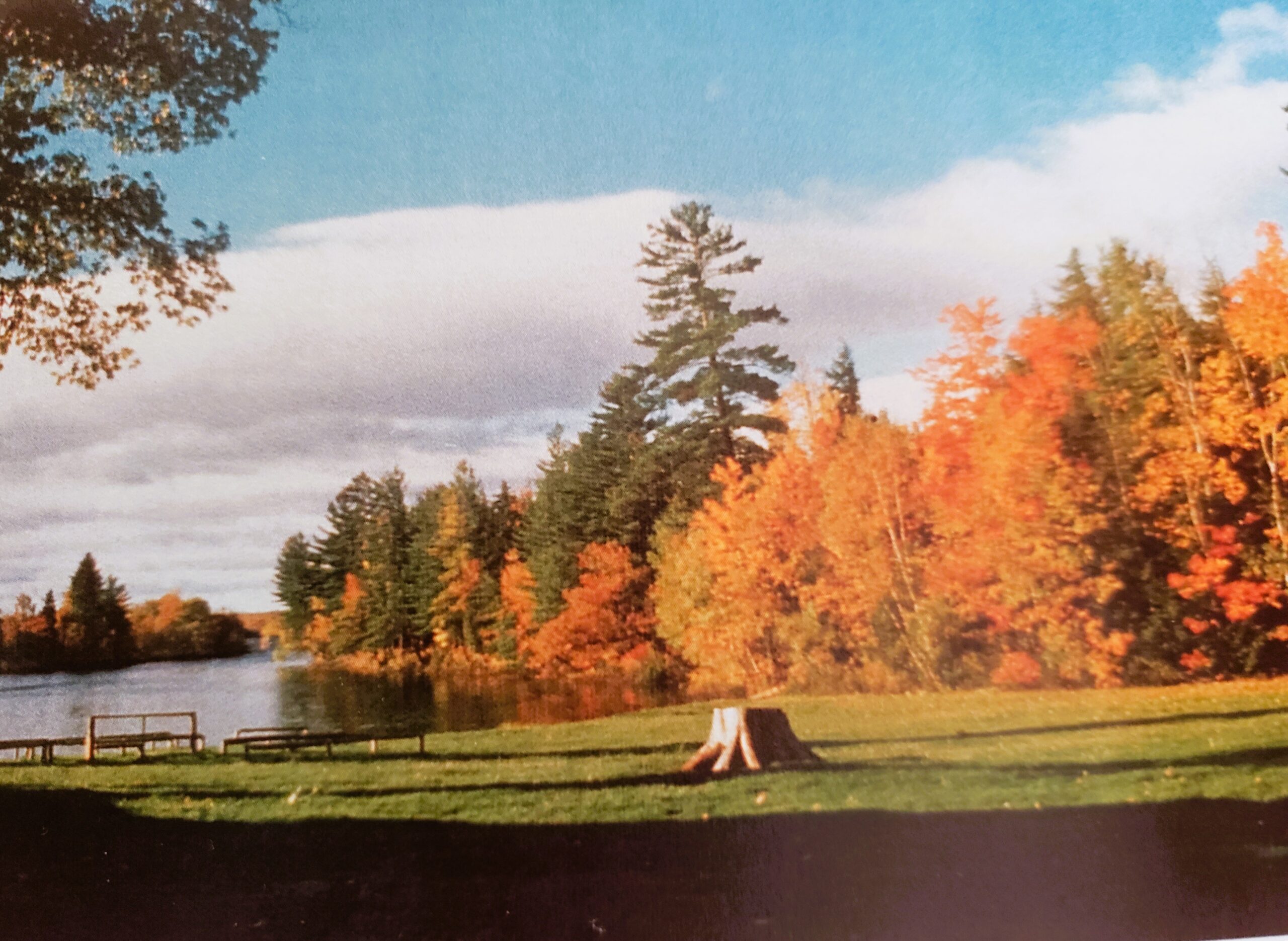
Autumn view of the Cove from Castle Harmony | Wild Goose Camp for Boys
(Photo courtesy of Deb Trauth Heidt)
*